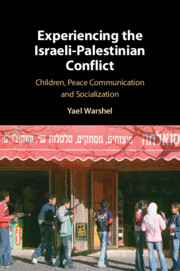Book contents
- Experiencing the Israeli-Palestinian Conflict
- Experiencing the Israeli-Palestinian Conflict
- Copyright page
- Dedication
- Contents
- Figures
- Tables
- Acknowledgments
- Note on the Text
- Abbreviations
- Introduction
- Part I The Encoding and Production of Israeli and Palestinian Sesame Street
- Introduction to Part I: Encoding and Production Methodologies
- 1 The Israeli-Palestinian Ethno-political Nationalist Conflict, the Arab-Israeli Multistate Conflict and Israeli and PalestinianSesame Street’s Disengagement with These Conflicts
- 2 The Modern World, or Interstate, System
- 3 The Encoding Process for Seasons One and Two of Israeli and Palestinian Sesame Street
- Part II Audience Reception of Israeli and Palestinian Sesame Street
- Part III Situating the Reception of Israeli and Palestinian Sesame Street in Mundane, Intractable Conflict Zone Practices
- Part IV Conclusions and Recommendations to Improve Peace Communication Research, (Evidence-Based) Practice and Conflict Intractability Interpretation
- Book part
- References
- Index
- Plate Section (PDF Only)
Introduction to Part I: Encoding and Production Methodologies
from Part I - The Encoding and Production of Israeli and Palestinian Sesame Street
Published online by Cambridge University Press: 08 July 2021
- Experiencing the Israeli-Palestinian Conflict
- Experiencing the Israeli-Palestinian Conflict
- Copyright page
- Dedication
- Contents
- Figures
- Tables
- Acknowledgments
- Note on the Text
- Abbreviations
- Introduction
- Part I The Encoding and Production of Israeli and Palestinian Sesame Street
- Introduction to Part I: Encoding and Production Methodologies
- 1 The Israeli-Palestinian Ethno-political Nationalist Conflict, the Arab-Israeli Multistate Conflict and Israeli and PalestinianSesame Street’s Disengagement with These Conflicts
- 2 The Modern World, or Interstate, System
- 3 The Encoding Process for Seasons One and Two of Israeli and Palestinian Sesame Street
- Part II Audience Reception of Israeli and Palestinian Sesame Street
- Part III Situating the Reception of Israeli and Palestinian Sesame Street in Mundane, Intractable Conflict Zone Practices
- Part IV Conclusions and Recommendations to Improve Peace Communication Research, (Evidence-Based) Practice and Conflict Intractability Interpretation
- Book part
- References
- Index
- Plate Section (PDF Only)
Summary
My first mission as I evaluated Israeli and Palestinian Sesame Street as a PeaceComm intervention was to understand the logic behind how it was designed. In order to assess whether what the Sesame Street audiences interpreted was indeed a direct (or even an indirect) result of the producers’ intentions, and so whether the intervention was effective precisely because of the producers’ efforts, I conducted an encoding study alongside my decoding study. This additional analysis outlines what features comprise the symbols the authors of these texts (in this case, the television producers and all those involved in the Sesame Street coproductions) attempted to include in the series, and what was rendered ultimately in the finished text. An encoding study aims to achieve this inasmuch as a text state can ever be assumed to be stable, given that audiences, or readers, do not necessarily read the text as planned.
- Type
- Chapter
- Information
- Experiencing the Israeli-Palestinian ConflictChildren, Peace Communication and Socialization, pp. 65 - 66Publisher: Cambridge University PressPrint publication year: 2021



